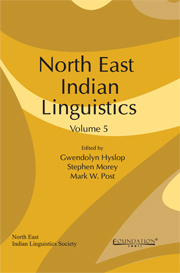Book contents
- Frontmatter
- Contents
- About the Contributors
- Foreword
- A Note from the Editors
- Contact and genetic linguistics
- 1 Koch dialects of Meghalaya and Assam: A sociolinguistic survey
- 2 The Siyom River Valley: An essay on intra-subgroup convergence in Tibeto-Burman
- 3 On the internal phylogeny of East Bodish
- Historical-comparative Tibeto-Burman grammar
- The North East Indian noun phrase
- Assamese grammar
- Advances in Boro-Garo phonology
- Poetics and text
3 - On the internal phylogeny of East Bodish
from Contact and genetic linguistics
Published online by Cambridge University Press: 05 September 2013
- Frontmatter
- Contents
- About the Contributors
- Foreword
- A Note from the Editors
- Contact and genetic linguistics
- 1 Koch dialects of Meghalaya and Assam: A sociolinguistic survey
- 2 The Siyom River Valley: An essay on intra-subgroup convergence in Tibeto-Burman
- 3 On the internal phylogeny of East Bodish
- Historical-comparative Tibeto-Burman grammar
- The North East Indian noun phrase
- Assamese grammar
- Advances in Boro-Garo phonology
- Poetics and text
Summary
Introduction
The term ‘East Bodish’ was first used in Shafer (1954) to identify a proposed family of languages to which Dakpa, a language spoken Southeast of Lhasa, belonged. Shafer (1954) noted that Dakpa, and therefore ‘East Bodish’ languages were closely related to, but not directly descended from Classical Tibetan. Since then, several other languages have been identified as East Bodish. A majority of these languages are found in Bhutan, but some spill over into Tibet and Arunachal Pradesh as well.
The East Bodish languages, in general, are amongst the most poorly described in all of Tibeto-Burman, in particular in comparison to their other Bodic cousins (e.g. Newar, Kiranti languages, Tamang). The studies I am familiar with are presented in §2. Other than van Driem (2007), showing the close relationship between Dakpa and Dzala, there has been no attempt to sort out the relationship amongst the East Bodish languages.
The aim of this chapter is to make new data available while also proposing the first tentative internal phylogeny amongst the languages within East Bodish. In §2 I provide the relevant background on East Bodish languages, including approximate location and number of speakers. §3 presents the data and arguments that confirm van Driem (2007)'s analysis that Dakpa and Dzala form a subgroup within East Bodish. §4 discusses the placement of the dialect of Hengke spoken in Phobikha, called Phobjip, in East Bodish and §5 discusses Chali.
- Type
- Chapter
- Information
- North East Indian Linguistics , pp. 91 - 110Publisher: Foundation BooksPrint publication year: 2013
- 5
- Cited by



